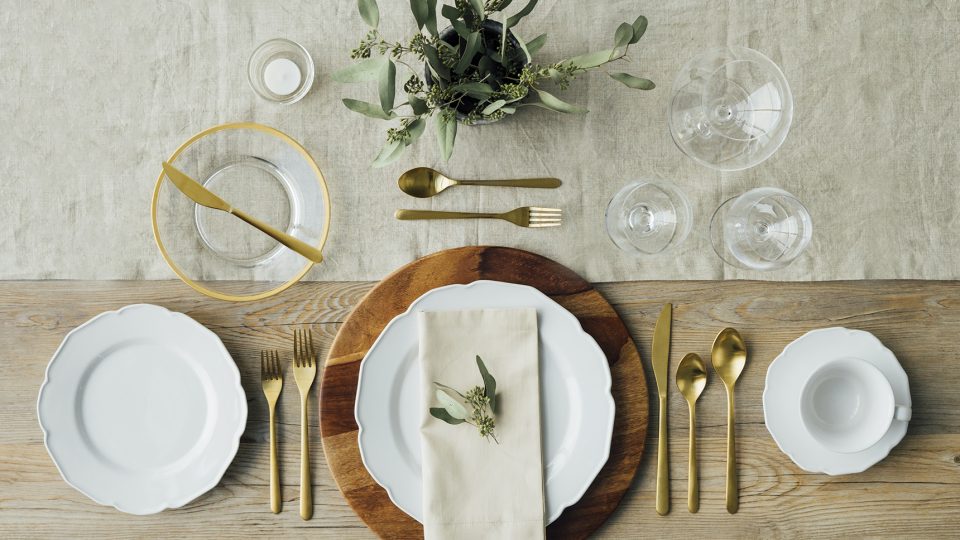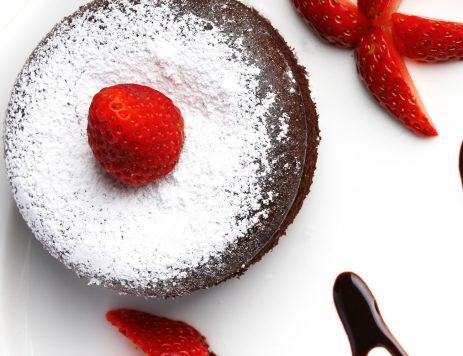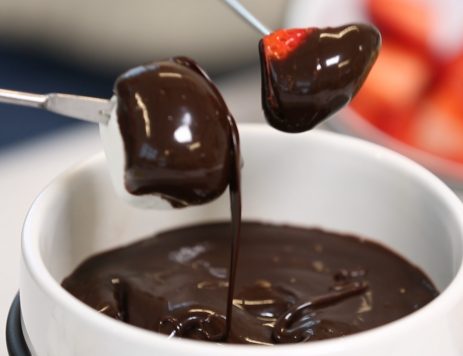
5 Classic Table Settings Every Host Should Know
The dinner table is a special place — whether you’re sitting down for mac-and-cheese with the kids, or enjoying an intimate dinner with close friends. It’s a place to step away from the hectic pace of life and revel in the simple joy of togetherness.
Elevate your dinners at home by learning the proper table settings for each occasion.

1. Basic Table Setting
Pizza night? Eating alone? You can still set a nice table for dinnertime:
- Start with a simple, woven placemat in front of each seat.
- Place your everyday ware (or melamine plates) in the middle of each placemat.
- Set a folded napkin on the left side of the plate.
- Top the napkin with a dinner fork and place a dinner knife to the ride of the plate.
- Finish with a water glass above the knife.

2. Informal Table Setting
If you’re sitting down for a family dinner or a casual dinner date, add a few extra touches to celebrate the gathering. Start with the basic table setting then you add the extras:
- Use a decorative napkin or a cloth napkin (instead of a paper napkin), and place it under the fork.
- Add a soup spoon to the right of the knife. A salad fork is optional, but if you choose to use it, it should go on the left of the plate (outside the dinner fork).
- Place the wine glass to the right of the water glass, which should be above the knife and spoon. Stemless glassware is acceptable.
- If eating family-style, the serving dishes are brought to the table, and placed on cork or woven trivets.

3. Formal Table Setting
For fancy dinner parties or holiday meals, it’s time to step up the table setting a notch! Impress your guests with a tablescape that shows as much thought and care as you put into the food. Start with the informal table setting and then:
- Spread your best tablecloth or table runner across the table. The drop should be about a foot from the table, at lap level.
- Place candles and flowers in the center of the table. Unscented are highly recommended to avoid any interference with the aroma of the food. Use low arrangements of flowers to prevent distractions.
- Replace everyday linens with lovely placemats and your best cloth napkins, which are folded and put across the center of the dinner plate.
- Use heirloom dishes (or china) and high-quality silver flatware.
- Add a bread plate and small butter knife above the forks and a salad plate to the direct left of the forks.
- Place a dessert fork and spoon above the plate. (This is optional since these utensils can also be brought out with the dessert course.)
- If necessary, add a steak knife to the right of the plate.
- Use stemmed wine glasses: The white wine glass is placed to the lower right of the water glass, and the red wine glass is placed above them so the three glasses form a triangle.
- To channel a fine-dining vibe, place a charger (a large decorative plate) under the dinner plate.

4. Five-Course Table Setting
Pull out all the stops for a formal, five-course feast, which typically consists of soup, salad, fish course, main course, and dessert. Start with the formal place setting steps outlined above, then:
- Add a Champagne flute further back behind the white wine glass.
- Place a sherry glass closer to the front, ahead of the red wine glass.
- If you’re serving a fish course, add a fish fork between the salad and dinner forks and a fish knife between the dinner knife and soup spoon.
- To top it off, include a name card on each place setting.

5. Buffet Table Setting
For potlucks and other occasions when there are too many guests to sit at one table, a buffet can be an easy, efficient service method. Create a stress-free buffet setup, using the following guidelines:
- Consider the flow of traffic:
- Place the food and drinks on separate tables arrangement to avoid traffic jams near the seating areas.
- Create a designated drink station with beverages, ice, glassware, cocktail napkins, straws, etc.
- At the food table, place plates at the beginning of the buffett with napkins and cutlery at the end.
- If space permits, create a separate area for snacks, finger foods, cheese plates, etc.
- Arrange the food on the buffet:
- Start with the hottest plates, ending with the coldest.
- Use chafing dishes to keep dishes warm. (They will not stay hot enough without them.)
- Use ice to keep things chilled.
- Leave enough space in front of the serving dishes so guests can set their plates down.
- Arrange the dishes on multiple levels: Repurpose cake stands, or place serving dishes atop sturdy objects to create a tiered effect. Not only is this method pleasing to the eye, but it also helps guests clearly see all of their options.
- Write short description cards to go in front of each dish. If you are expecting guests with food allergies or dietary restrictions, it’s considerate to add which dishes are vegetarian, gluten-free, nut-free, etc.
- Place condiments, dips, and other sauces next to the dishes they pair with.
- Supply extra piles of napkins in the seating areas.
- Use disposable tablecloths if you’re using plastic or folding tables for the food and drink stations. In addition to disguising the table surface, it also helps a lot with clean up.



